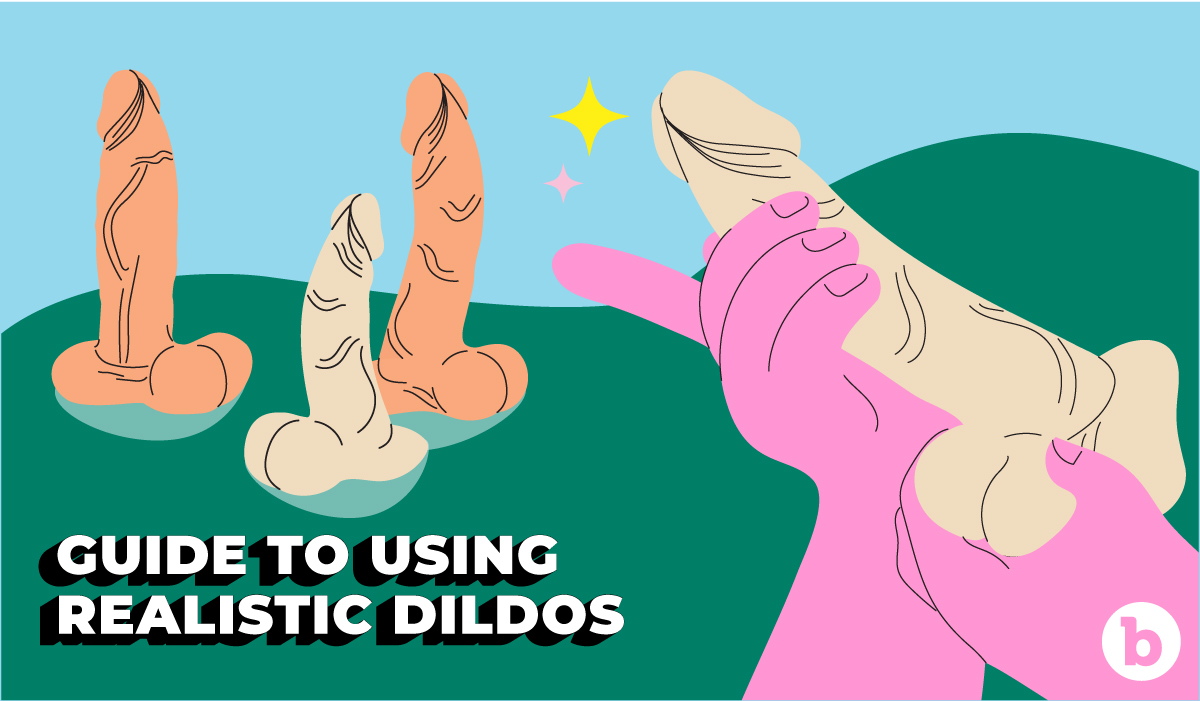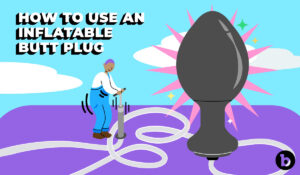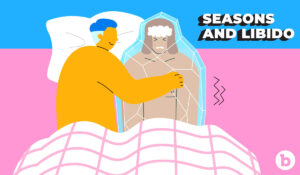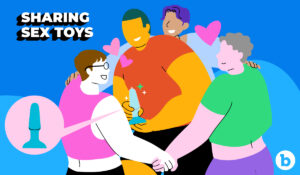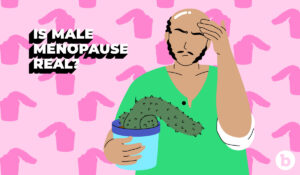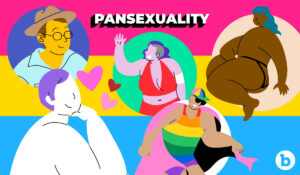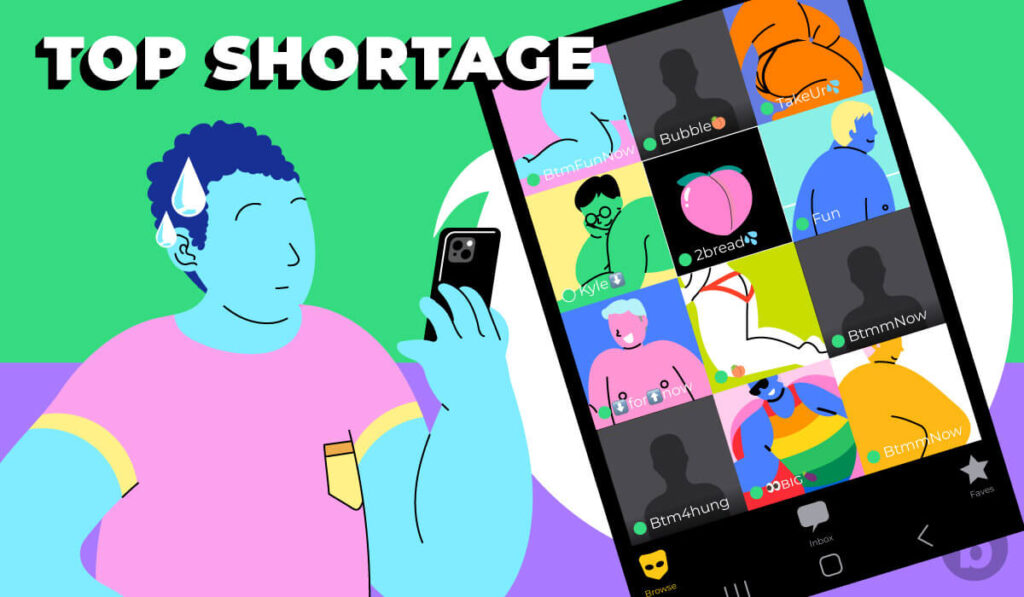
Is There Really A Top Shortage in The Gay Community?
Reporting from what many on Grindr call "Bottom City," Bobby Box is on the case of the missing tops. Where did they all go and why might it seem like your area is a bit bottom heavy? Our latest Queeries column fills you in on the "Top Paradox."
Mere moments ago, I scrolled across a Grindr profile labeling Toronto the "city of cranky bottoms." This is far from the first time I've heard Toronto labeled as such, and in my personal experience (as a bottom in Toronto, go figure), it's pretty accurate. But this belief extends far beyond the queer metropolis I live in. I mean, saying you live in a "bottom city" is as quintessentially queer as asking someone's name after they've bred you.
And yet, statistics don't support the generalization. This past December, gay cruising app Sniffies published their annual recap of data finding the majority of their user base identifies as vers (36 percent), while tops and bottoms were evenly distributed (15 percent). Vers bottoms only slightly outnumbered vers tops (19 percent to 15 percent), and similar surveys from the past have more or less found the same result.
The minimal research published in a medical journal is so dated it recruited its sample from Craigslist. However, the study also found that most had identified as vers, with tops and bottoms breaking even. So if these numbers are so similar, why are so many gays insistent that bottoms far outnumber tops in our community?
There is no way to determine the perception for certain, of course, but I did speak with you, my incredibly insightful audience, as well as some accredited and studied individuals to delve into the topic and share their opinions and insights. I was able to distill all of the fantastic opinions down to two compelling theories.
THEORY ONE: PERFORMANCE ANXIETY
Performance anxiety is something I see a lot of in my DMs. Now I first want to make it clear as douche water that I understand that bottoming is no easy feat, but it's important to emphasize that topping comes with pressures of its own, specifically regarding the unrealistic expectations we observe in porn.
If porn were our most visible sample of sexuality (which, for queer people, it kind of is), we are led to believe that the average penis would be remarkably large, practically the size of a water bottle, when studies show the average penis is around 5.1 to 5.5 inches. This could be why the average penis is nearly an inch shorter than what most perceive the average to be. Coincidentally, research has also found that those who believe that their penises are below average are "significantly" more likely to identify as bottoms, whereas those who perceived their penises as above average were significantly more likely to identify as tops. Take from that what you will. But considering 45 percent of penis-owners wish their members were bigger may also suggest an abundance of people who default to bottoming, even if that's not what they prefer.
Related: Watch & listen how to be a better top with Zachary Zane!
And then, of course, there's the expectation that penises must become erect in an instant, remain hard during intercourse, and ultimately climax at a time deemed desirable for all parties involved. This can place a lot of pressure on a person, especially since it's considered "normal" to have trouble getting or keeping an erection for up to 20 percent of sexual encounters.
It's no secret that porn is created for entertainment, but because our school's sexual education is so abysmal (for example, did you know that only 13 states require that sex ed be medically accurate?) many people default to porn as their primary source for education because it's easily accessible and stimulating. This can be especially true for queer people, who are largely ignored in sexual education.
In the same way Hollywood will cast a gorgeous actress as undesirable or dowdy, porn can make the exceptional seem average. This understandably causes stress and anxiety for a number of different reasons. One study even suggests that the more porn one watches, the more difficult it becomes to orgasm as it elicits sexual insecurity.
"Among my clients, I do hear how many would never self-label as a top because of the comparison to our porn-inspired ideal, where a top is masculine, hung like a God, and ready to fuck at a moment's notice," Craig Cassey, queer-identifying life coach, says. "They share a fear of setting themselves up for disappointment if they can't compare. Hence, being vers/ btm can feel safer, even if you prefer topping because you no longer face the fear of not meeting an OnlyFans ideal of what a top should look like."
THEORY TWO: INTERNALIZED HOMOPHOBIA AND BOTTOM-SHAMING
As queer people, it can be difficult to unlearn everything we were taught growing up, which can grow and manifest, becoming what's known as internalized homophobia: a queer person's negative social attitudes toward self. Many speculate that this type of shame plays a crucial role in the perceived abundance of bottoms.
Growing up in a heteronormative and patriarchal society, we have no choice but to exist within their ideologies. We are taught that men are masculine and the sexually dominant, penetrative partner, whereas women are feminine and the sexually submissive, receptive partner. Since that's all we know, queer people apply this framework to our sexual and social relationships.
This was more or less confirmed by this study, which stated: "For some participants, the terms top and bottom referred to highly gendered identities reflecting an essentialist, heterosexual construction of inserting and receiving during a given sexual encounter." This study, which was rife with disappointing testimonials, also found that some gay men believe bottoms to be "gayer" than tops.
Internalized homophobia places a premium on heteronormative concepts of masculinity. And because we view masculinity as premium, tops are inherently given more value and therefore may be perceived as rarer. If a top doesn't boast these hyper-masculine qualities, they are either deemed as undesirable or dismissed as bottoms.
"If your radar for tops only includes men who fit a certain masculine ideal, then you're likely to see many more supposed bottoms than tops, especially as our community expands our gender expression and self-understanding," Cassey says.
While it is definitely incorrect to say bottoms are gayer than tops, they might generally be more comfortable with their sexuality. A study referenced in Scientific American found that the tops are much more impacted by internalized homophobia than bottoms and versatiles. This same study also found that tops were more likely to "reject a gay self-identity" and have had sex with a woman in the last three months.
For this reason, tops might be less visible on apps, etc. due to the discomfort of publicly sharing their sexuality. "Many also have the choice of setting filters, which could mean that removing those blank profiles might actually be removing some of these men who are more private/discreet," Raymond McKie, Ph.D. candidate at the University of Ottawa, adds.
Some particularly disappointing research reports that gay men will even use the word "bottom" to criticize men with feminine traits. "Oftentimes, the use of the word 'bottom' is less about someone's preferred sexual position and, instead, becomes coded language for any type of 'undesirable' qualities among gay men," psychotherapist, Daniel Olavarria, confirms. "Suddenly someone who is considered feminine, shallow, or 'messy' becomes indicative of this overabundance of bottoms."
Queer therapist, Madison McCullough, adds to this point, mentioning that because bottoming is often seen as the less powerful position that the generalization is also misattributed as an identity to those who are marginalized or disempowered in other ways, such as through racism, fatphobia, classism, and ableism.
Research has already verified that race plays a factor, with Asian folks often labeled as feminine bottoms and Black folks labeled as masculine tops. While this particular study found the generalization was mostly accurate in regard to their preferred sexual role, researchers questioned whether these tendencies reflected innate preferences or the internalization of stereotypes.
Gay men have always feared the feminine label. It's part of the reason why leather has become synonymous with our community. The uniform rejected femininity, which was strongly associated with gay men at the time. Hairy, burly bears would later do the same to distance themselves from smooth and slender twinks. It isn't until fairly recently that we've begun to embrace all forms of gender expression, though we still have a long way to go.
Obviously, there are a number of factors that influence the belief that bottoms far outnumber tops. ARe there in fact more bottoms than tops but people aren't willing to confess in fear of being perceived as feminine? Maybe. Are the versatiles who represent the lion's share of sexual roles more prone to bottom? Perhaps. Will we ever truly know the reason for this perception? No, probably not.
All we can really do is speculate. Since, unfortunately, most of the mystery surrounding queerness boils down to rejection and a systemic shame that we weren't born with, but were taught. As a result, much of our queer history remains uncertain because we weren't (and in some areas, still aren't) able to exist out in the open like others. Regardless: bottom, top, versatile, side, or whatever you identify as, a label is a label, and only you get to choose how important they are to your identity, and how rigid their boundaries are.
In the end, there are plenty of people to fuck, no matter which role you prefer. But if you open your mind, understand that our bodies aren't machines, and perhaps assess why you might be attracted toward a certain type, you may find that there are indeed plenty of fish in the sea. Tops too.
